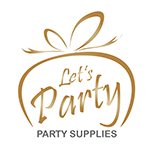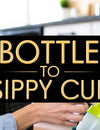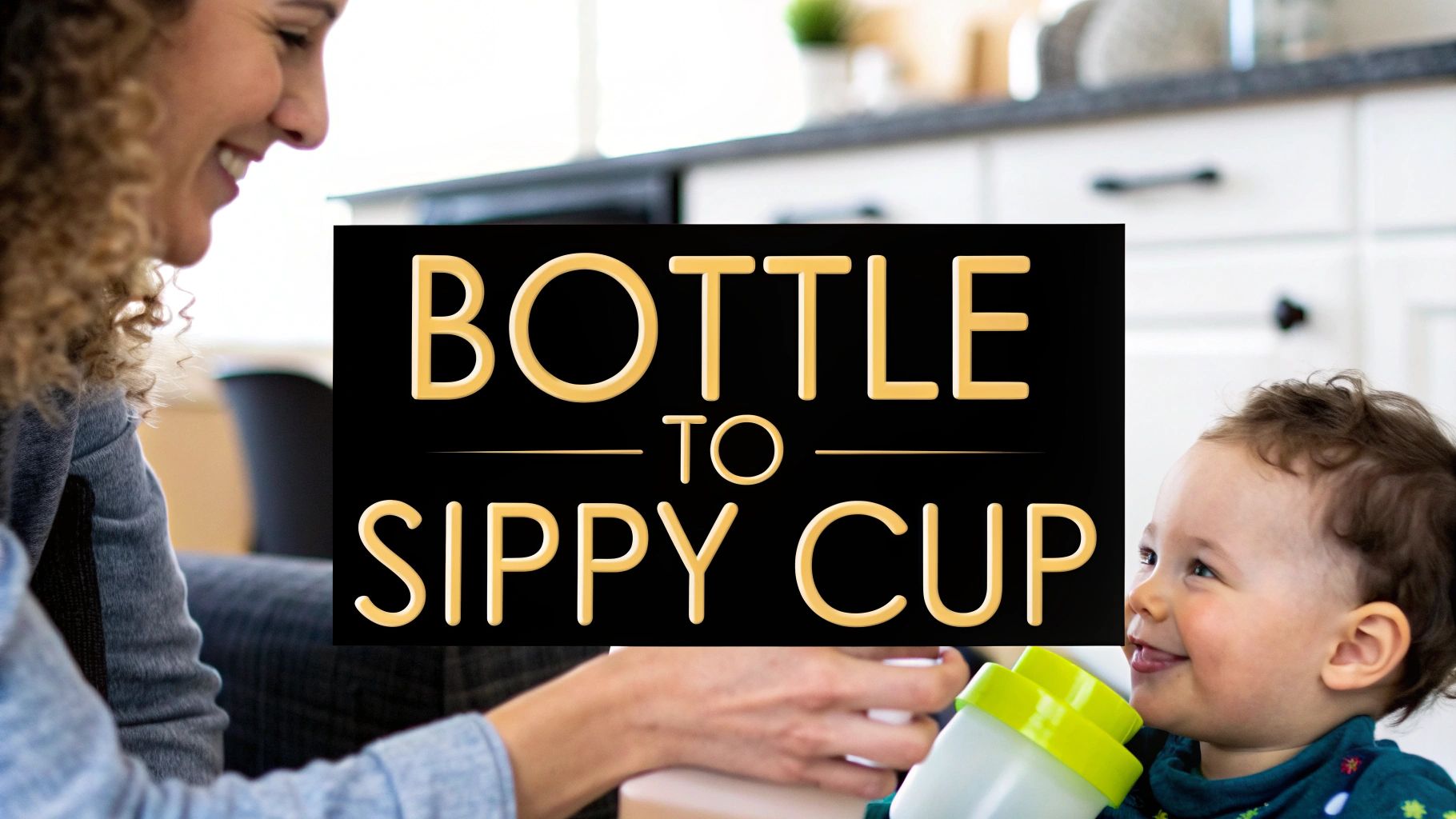
Making the move from a bottle to a sippy cup is a big step, but figuring out the perfect time can feel a little fuzzy. While most pediatricians suggest introducing a cup somewhere between 6 and 9 months, with the goal of ditching the bottle by 18-24 months, it's not a race.
The real secret is to watch your child, not the calendar. Their unique developmental cues are your best guide.
This isn't about hitting a specific date on a chart. It’s about recognizing when your little one is truly ready to take on this new skill.
Signs Your Child Is Ready for a Cup
Before you even buy a sippy cup, it helps to have a good sense of where your child is at developmentally. A general familiarity with understanding child development basics and key developmental milestones can make spotting these readiness signals much easier.
Keep an eye out for these real-world clues:
- Sitting Up Strong: Can your baby sit confidently in their high chair without toppling over? Strong head and neck control is non-negotiable for safe sipping and swallowing.
- Curious Hands: Have you noticed them reaching for your water glass or trying to swipe your cup? That curiosity is a fantastic sign they’re mentally on board to try something new.
- Eating Solids Like a Champ: If they’re already handling purées or finger foods, they've been practicing the very same oral motor skills needed to drink from a cup.
There’s good reason for this transition. Leaning on the bottle for too long can sometimes interfere with the oral muscle development crucial for clear speech, not to mention it can increase the risk of tooth decay.
While that 18-24 month guideline is the standard advice, what happens in practice can look a little different. One study, for instance, found that while 50% of toddlers were using sippy cups by 12 months, that number only rose to 80% by 24 months, showing a clear gap between recommendations and reality for many families.
Picking the Perfect Sippy Cup for Your Toddler
Ever feel dizzy standing in the baby aisle? The wall of sippy cups—with all their different spouts, straws, and handles—is enough to make any parent's head spin. The reality is, there’s no single "best" cup. The right one really depends on your child’s age and where they are developmentally.
Finding that perfect fit is the secret to a much smoother transition away from the bottle. Trust me, it can save you from collecting a cabinet full of sippy cup rejects. Let’s break down the main types you'll find so you can choose wisely from the start.
The Lowdown on Different Cup Styles
Each type of sippy cup is designed to help your little one master a new skill on their path to drinking from a regular glass.
- Soft Spout Cups: These are usually the first stop on the sippy cup train. The spout is soft and pliable, which feels a lot like the bottle they’re used to. It's often the most intuitive first step for babies just learning how to go from bottle to sippy cup.
- Hard Spout Cups: A step up in durability, these are fantastic for toddlers who have started teething and love to chew on everything. They require a slightly stronger sucking action, which is a good progression.
- Straw Cups: Many feeding specialists and speech therapists love straw cups, and for good reason. Drinking from a straw helps develop the oral muscles needed for clear speech and promotes a more mature swallowing pattern.
- 360-Degree Cups: These are pretty clever. A special valve-sealed rim lets your child sip from any edge—just like a grown-up cup—but without the massive spills. They're a brilliant final step before you hand them an open cup.
This visual guide can help you spot the signs that your little one is ready to begin.
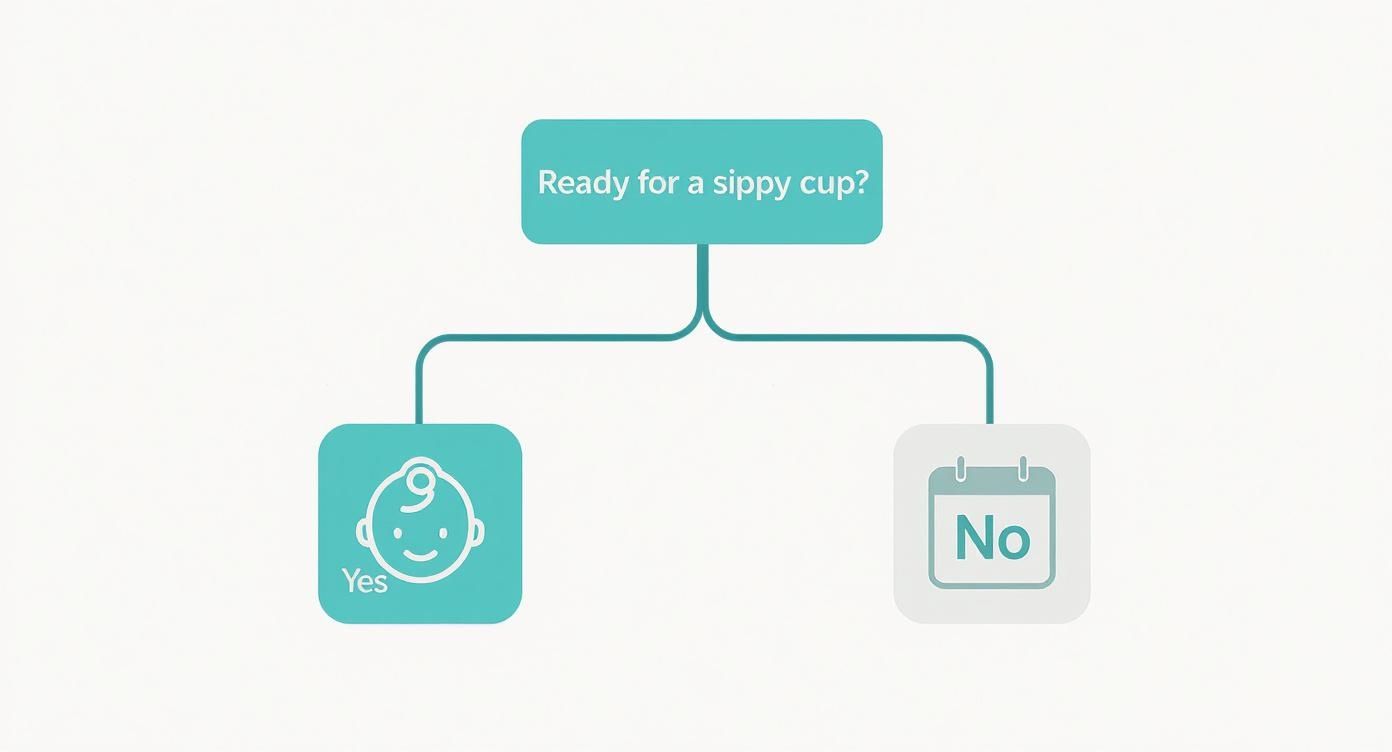
As you can see, timing is everything. Making sure they're actually ready is half the battle.
Sippy Cup Comparison Guide
To make it even simpler, here's a quick comparison of the most common sippy cup types to help you choose the best fit for your child.
| Cup Type | Best For Age | Key Feature | Potential Drawback |
|---|---|---|---|
| Soft Spout | 6-9 months | Feels familiar, like a bottle | Can be easily chewed through |
| Hard Spout | 9-12 months | Durable and chew-proof | Requires a stronger suck |
| Straw | 9+ months | Promotes oral motor skills | Can have tricky valves to clean |
| 360-Degree | 12+ months | Mimics an open cup, spill-resistant | May have a slight learning curve |
Ultimately, you might try a couple of these before finding the one your child clicks with, and that's perfectly okay.
Features That Genuinely Make a Difference
Beyond the spout, a few practical features can make your life so much easier. First, always check that the cup is made from BPA-free materials. That's non-negotiable.
Also, think about cleanup. A cup with a dozen tiny parts is a nightmare to wash and a perfect hiding spot for mold. Simpler is almost always better.
A cup that's a breeze for your child to hold but a pain for you to clean won't be your go-to for long. Look for simple designs and easy-to-grip handles.
Finally, as you're gearing up for this next phase, it helps to think about what other essentials can streamline your parenting journey. If you're building out your list, you might find some great ideas in our guide on the top 10 baby registry essentials for new parents.
Gentle Strategies for a Smooth Transition
So, you’ve figured out your child is ready and you’ve picked out the perfect cup. Great! Now for the real part: actually making the switch without turning every meal into a power struggle. The absolute key here is to be gentle and patient, moving at your child’s pace, not the one you have in your head.
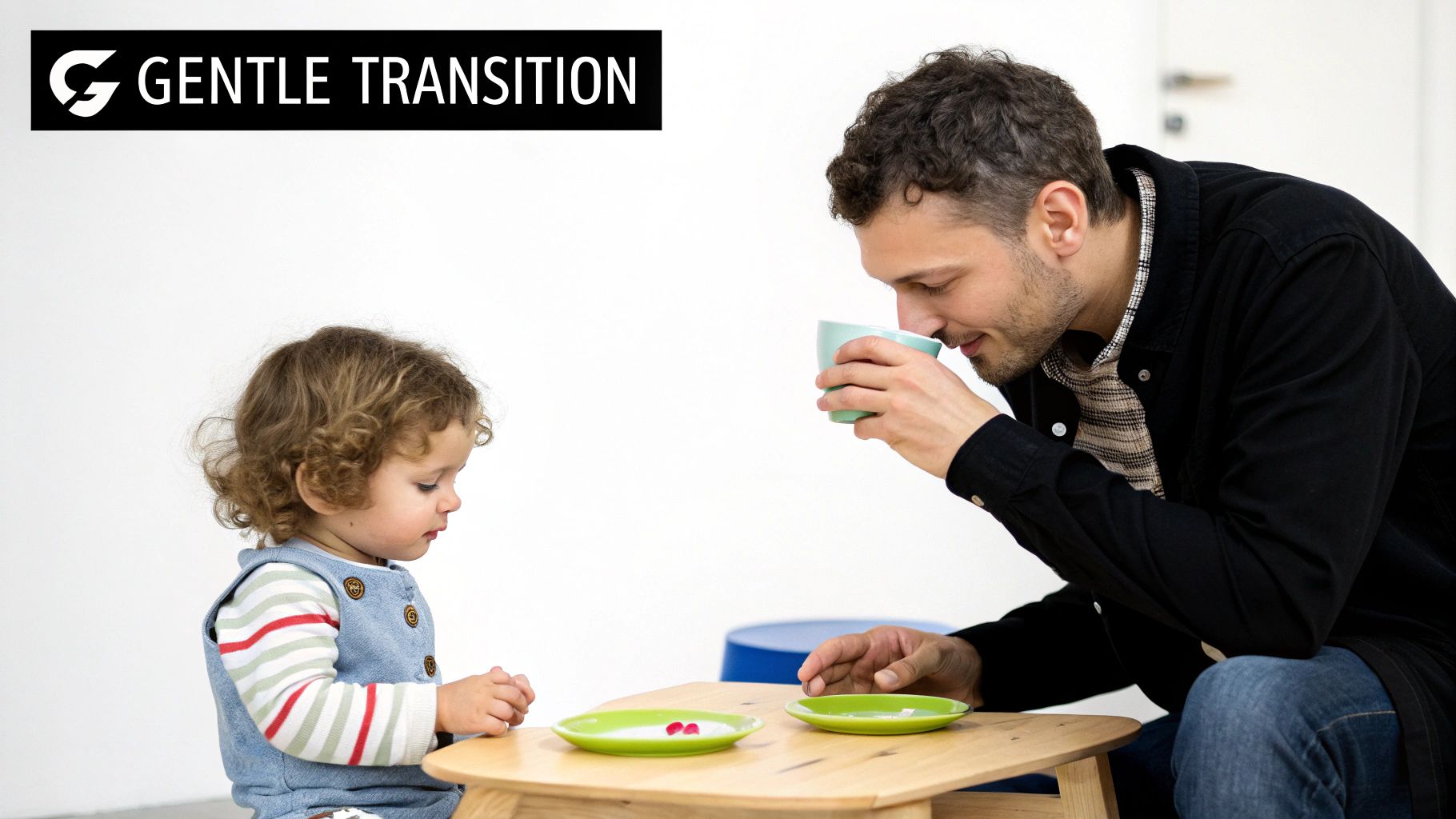
Throw rigid timelines out the window. This whole process is about making the sippy cup feel like a normal, positive part of their day, not something to dread. A calm, consistent, and low-pressure vibe will help your little one embrace this new "big kid" skill with confidence.
The Gradual Swap Method
One of the most successful (and least dramatic) strategies is to replace just one bottle feeding at a time. Whatever you do, don't start with the cozy morning or bedtime bottle. Those are often tied to comfort and routine, making them the hardest to give up.
Instead, pick a midday feeding—lunch or an afternoon snack is perfect. Your child is usually more alert and engaged then, and less likely to be looking for the comfort a bottle provides.
Here’s what that might look like in practice:
- Week 1: Offer a sippy cup with milk only at lunchtime. All other feedings stay as bottles.
- Week 2: Keep the lunchtime cup and now swap the mid-morning snack bottle for a cup, too.
- Week 3 and beyond: Continue replacing one bottle at a time, always saving that deeply ingrained bedtime bottle for last.
This slow-and-steady approach prevents your child from feeling overwhelmed by too much change at once, which makes the whole transition feel much more natural.
Remember, the goal is progress, not perfection. If they totally reject the cup one day, don't push it. Just stay positive and offer it again at the next meal.
Making the Sippy Cup Fun and Familiar
Before you even think about putting milk in it, let the new cup be a toy. Let them hold it, chew on it, bang it on their highchair—whatever! This takes all the pressure off and just makes it a familiar object.
Try putting a tiny bit of water in it and leaving it where they can play with it. Another huge motivator is seeing you use your own cup. Pour yourself some water, take a big sip, and say "ahh!" with a smile. Toddlers are natural copycats, and their curiosity might just get the better of them.
Many parents have great success when they combine this with other feeding strategies that give their child more control. For example, if you're following something like the baby-led weaning approach, which champions self-feeding, then introducing a cup they can hold themselves is a really logical next step. It creates a supportive environment where your child feels like they're in the driver's seat.
What to Do When They Just Say "No"
Even with a perfect plan, you're bound to hit a few snags. Toddlers are masters of refusal, and seeing them push that new cup away is a totally normal—if frustrating—part of learning how to go from bottle to sippy cup. This is where you get to pull out your creative parenting tricks.
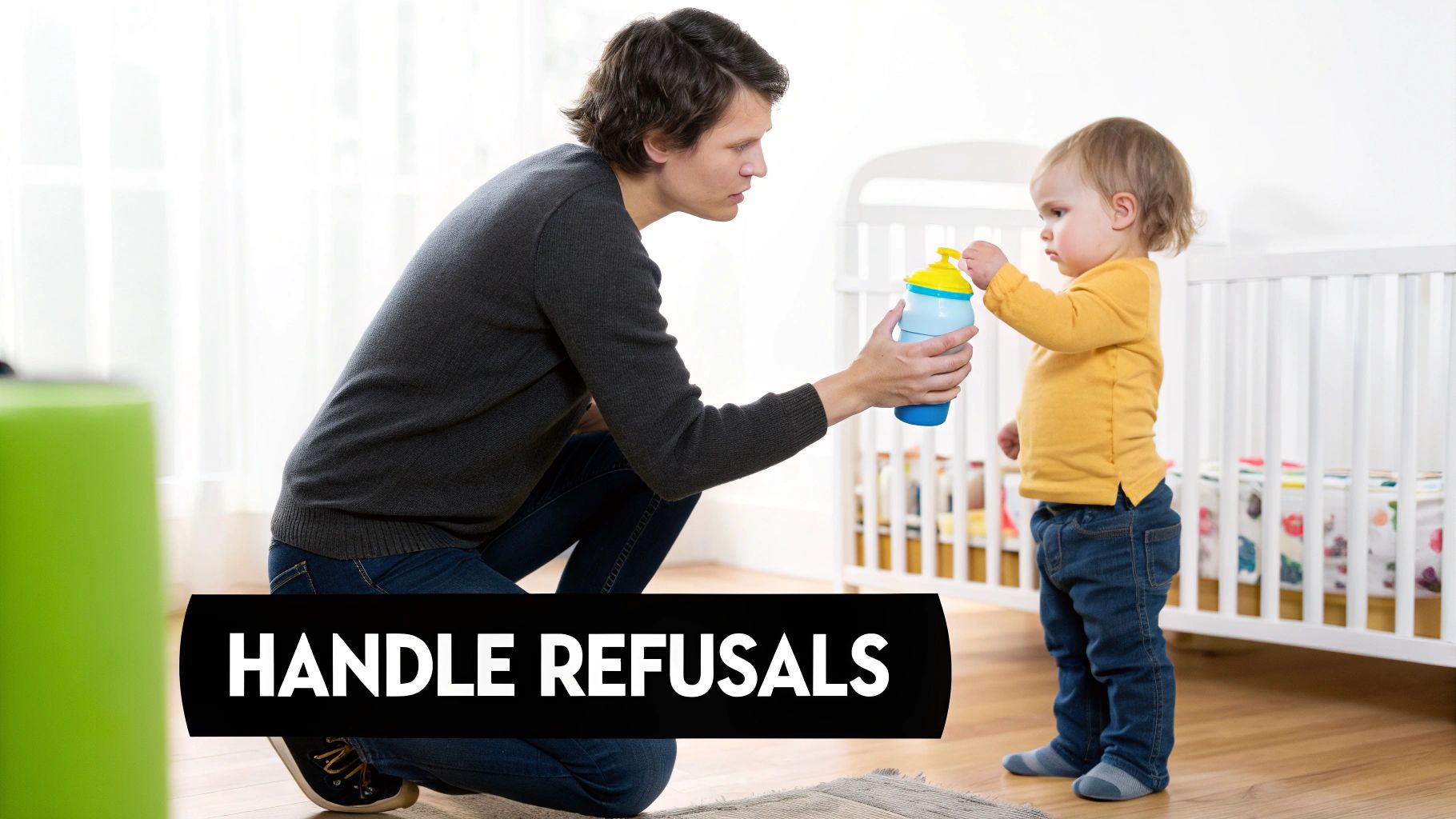
A classic roadblock is the "milk vs. water" standoff. You might find your little one happily sips water from their sippy cup all day, only to reject it the second it's filled with milk. This is because they've built a powerful association between the bottle, comfort, and the taste of their milk.
Don't panic if their milk intake dips for a little while. As long as they're staying hydrated with water and getting calcium from other sources like yogurt or cheese, their nutritional needs are likely being met just fine.
Clever Fixes for Cup Refusals
When your toddler digs in their heels, the last thing you want is a mealtime power struggle. The key is to avoid confrontation and instead tweak the situation to make the cup more interesting and the bottle just a little less appealing.
- Switch Up the Temperature: Are they used to warm milk from their bottle? Try offering cold milk in the sippy cup. The change in temperature can be enough to break that old bottle habit and make it feel like an entirely new, refreshing drink.
- Try Off-Peak Hours: Instead of pushing the milk-filled sippy cup during a main meal, offer it at snack time. When the pressure is off and they aren't ravenously hungry, they might be more curious and willing to experiment.
- Redirect Emotional Attachments: The bedtime bottle is usually the hardest to give up because it’s so deeply woven into their comfort routine. Start introducing a new comforting object, like a special stuffed animal or a soft blanket, to help fill that role.
Keep in mind that physical discomfort can also be a factor. If your child is teething, a new, hard spout might be painful on their sensitive gums. Finding ways to soothe their mouth can make a world of difference. You can explore how to find the best teething toys for babies to help ease their discomfort during this tricky phase.
Ultimately, patience and consistency are your greatest allies. Stay calm, continue to offer the cup without making it a big deal, and cheer for every little win. Each sip is a step forward.
Life After the Sippy Cup: What Comes Next
The sippy cup is a fantastic bridge from the bottle, but it's not the final destination. The next major milestone in your child’s drinking journey is mastering an open cup. This is a crucial step for developing mature, big-kid swallowing patterns that don't depend on a spout or valve.
While incredibly convenient, relying on valved sippy cups for too long can sometimes delay the oral motor skills needed to manage a regular glass. The real goal is to move beyond the sippy cup, usually introducing an open cup sometime after their first birthday, once they're pretty confident with their current cup.
Making the Move to an Open Cup
Introducing an open cup doesn't automatically mean your floors will be soaked 24/7. The secret is to start small and set your little one up for success.
- Start with Tiny Amounts: Begin by offering just an inch or two of water. This keeps spills to a minimum while they get the hang of tilting and sipping without making a giant mess.
- Choose the Right Cup: Small, weighted-bottom cups are absolute game-changers. They are much harder for wobbly hands to knock over, giving your toddler a huge confidence boost.
- Stick to Safe Sips: To protect those emerging teeth, it’s best to only offer milk or water in any type of cup. Try to avoid letting them sip on sugary juices throughout the day.
Think of the sippy cup as a training tool with an expiration date. Embracing the open cup is the true graduation, helping your child build lifelong skills for healthy drinking habits.
This transition is another one of those big developmental leaps, right up there with potty training. As you plan for these milestones, you can find helpful guidance on selecting the right tools, just like in our article about choosing from different kids potty chairs.
Got Questions About Switching to a Sippy Cup? Let's Get Them Answered.
When you're trying to ditch the bottle, a million little questions pop up. It's totally normal. Let's walk through some of the most common ones I hear from parents all the time.
What Should I Put in the Sippy Cup First?
My go-to advice? Start with water. Offer a sippy cup with a little water in it between meals. This takes all the pressure off. Your little one can explore it, chew on it, and figure out how it works without it being a substitute for their comforting milk bottle. Think of it as a fun new toy, not a meal.
Once they seem comfortable and can actually get some sips down, you can start offering milk in the cup. I usually suggest trying this with a midday meal first, as kids are often more flexible then than they are first thing in the morning or right before bed.
Don't be surprised if your child's milk intake drops for a little while. This is incredibly common. As long as they're drinking water and you're offering other calcium-rich foods like yogurt and cheese, a temporary dip is usually nothing to worry about.
Is It Too Late if My Toddler is Over 2?
Absolutely not. It's never too late! The game plan is pretty much the same, but you might just need a bit more patience since that bottle attachment can be extra strong by this age.
One of the best tricks for an older toddler is to give them some control. Take them to the store or let them browse online with you to pick out their very own "big kid" cup. Making a big deal out of it can work wonders. You could even have a little "bye-bye bottle" party to celebrate the milestone and make it feel like a positive step forward.
At FindTopTrends, we find the best baby care essentials to help you navigate these parenting milestones. Check out our collection of parent-approved products and make life a little easier.



